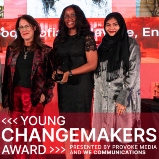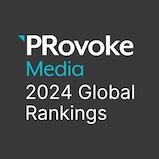Arun Sudhaman 28 Jul 2017 // 6:27PM GMT

If this week's research study from City College of New York's Branding and Integrated Communications (BIC) Program tells us nothing else, it is that the PR industry is clearly aware of the work it must do to create agencies that better reflect the diversity of the societies in which they operate.
The report, which is available here, was conducted by City College associate professor Angela Chitkara in conjunction with the Holmes Report, and features interviews with 16 CEOs and two former CEOs of major PR firms, including such names as Richard Edelman, Andy Polansky, John Saunders and Rob Flaherty.
I would recommend that everyone with a stake in the industry's future reads it. Because it clearly underlines that lip service is no longer enough for PR firms that are still dominated, particularly at the upper levels, by a homogenous demographic set. As Mastercard CEO Ajay Banga said in Davos earlier this year, "if you come from the same backgrounds, you’ll have the same blind spots and miss the same trends."
That should sound a distinct warning note for an industry that still struggles with gender imbalance in the C-suite and, as Golin CEO Matt Neale puts it, genuine "ethnic, social and economic diversity" throughout its ranks. To their credit, the CEOs interviewed in the study are alive to the issue. Many are taking steps, slowly perhaps, to spearhead the kind change that will transform their agencies — even if their responses sometimes make for uncomfortable reading for anyone expecting a faster rate of progress.
Most appear focused on hiring a more diverse staff. That is hardly surprising, but as Chitkara notes, it is no guarantee of a more inclusive workplace. For me, this is the study's critical finding — until PR firms become more culturally heterogeneous, they will struggle to hold on to people who feel that they simply do not fit into the prevailing workplace environment.
"Just because you have a mix of talent, doesn't mean your environment is diverse and inclusive," says Porter-Novelli CEO Brad MacAfee in the report. At our CCNY panel earlier this year, MacAfee recounted an example that involved African-American executives at his firm complaining that water-cooler conversations about TV shows rarely took into account the varying viewing preferences of different demographic groups. It may seem like a small point, but it is a pivotal one for the culture of an agency — if a person feels excluded from such mundane matters, then how seriously will be they taken on more important ones?
“The challenges are that even if you get good diverse candidates in, like people of color coming in at junior levels in an agency, they don’t stay because the agency hasn’t thought about how to provide the right community for them to address how they see the world, which is very different from how a white man or woman sees the world," notes M Booth CEO Dale Bornstein. "We need to know how a straight woman sees it versus how a homosexual or a gay woman sees it or a gay man would see it."
"People often focus on the need to build diverse teams and how integral that is to the fabric of an organization," adds Weber Shandwick CEO Andy Polansky. "But people don’t spend enough time thinking about inclusion. Even when companies are successful in bringing great diverse talent into an organization, they don’t take proper care in creating an inclusive environment."
It is the same issue, I would argue, that has stymied creative progress at many firms. There is still too much emphasis on looking and speaking a certain way — a kind of herd mentality that is hardly uncommon at corporate organizations. "Our field tended to hire smart articulate people who presented themselves well, but it’s never as creatively diverse as the advertising agency," agrees Ketchum CEO Rob Flaherty.
Yet, unless people feel comfortable in their own skins, they will never be able to express themselves in a way that brings forth emotionally resonant work. And unless agencies truly understand the full diversity of the communities they are engaging with, they will become increasingly irrelevant in a world of multiple cultures and experiences. It is an issue that only multiplies once US and UK firms, for example, export their offerings to markets on the other side of the world.
As Padilla CEO Lynn Casey puts it, "inclusivity is where the rubber meets the road, not only checking the box and getting X people of color but also making them feel welcome and making sure we understand and celebrate each other."
That may seem overly idealistic, but Casey is right to see diversity and inclusion as an opportunity rather than a challenge. Because the risk is obvious, outlined by Richard Edelman during his interview with Chitkara:
"Diversity in and of itself is not enough, and if you don’t have inclusion, people run away," says the Edelman CEO. "We have to move beyond representation and actually have engagement where people are learning from each other and are growing together. So diversity without inclusion won’t work, and that’s why you’re seeing people leave because they didn’t feel the same in an environment in which they can grow and develop."
To address the issue, there is clearly a need for more diversity at senior levels, for executives who can serve as visible role models and mentors and help to broaden an agency's cultural palette. But much more, outlines Chitkara, needs to be done, from better metrics (where Finn Partners' efforts clearly stand out) to initiatives such as implicit bias training, the creation of affinity groups and more robust 'onboarding' efforts to make new employees feel comfortable.
Better industry cooperation on the issue would not hurt either. Until then, a measure of scepticism can be forgiven. “I think people who say that they’re doing a good job or a better job in our industry, are hyperbolic, patting themselves on the back," says Bornstein. "I don’t think anybody is doing a good job at it."



































.jpg)

















